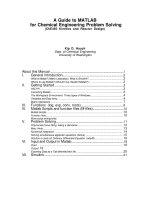HIGH VOLTAGE XLPE CABLE SYSTEMS Technical User Guide phần 1 docx
Bạn đang xem bản rút gọn của tài liệu. Xem và tải ngay bản đầy đủ của tài liệu tại đây (662.49 KB, 9 trang )
HIGH VOLTAGE XLPE CABLE SYSTEMS
Technical User Guide
High Voltage XLPE Cable Systems Techincal User Guide
Brugg Cables Page 2
Content
1. General information on High Voltage XLPE Cable Systems ______________
1.1. Introduction _______________________________________________
1.2. Cable selection process _____________________________________
1.3. Service life ________________________________________________
2. Cable layout and system design ___________________________________
2.1. Electrical field _____________________________________________
2.2. Capacity, charging current ___________________________________
2.3. Inductance, Inductive reactance _______________________________
2.4. Losses in cables ___________________________________________
2.5. Earthing methods, induced voltage _____________________________
2.6. Short-circuit current capacity __________________________________
2.7. Dynamic forces ____________________________________________
2.8. Metallic sheath types ________________________________________
3. XLPE Cable System Standards ____________________________________
4. Technical data sheets ___________________________________________
500 / 290 kV XLPE Cable
400 / 230 kV XLPE Cable
345 / 200 kV XLPE Cable
220 / 127 kV XLPE Cable
132 / 76 kV XLPE Cable
5. XLPE Cable Reference Projects from Brugg __________________________
3
3
3
4
6
6
6
7
7
8
10
11
11
13
14
20
High Voltage XLPE Cable Systems Techincal User Guide
Brugg Cables Page 3
1. General information on High Voltage
Cable Systems
1.1 Introduction
The development of high voltage XLPE Cable
Systems goes back to the 1960’s. Since then
production and material technology have
improved significantly, providing reliable and
maintenance-free products to the utility industry.
At present, numerous high voltage XLPE cable
systems with nominal voltages up to 500 kV and
with circuit lengths up to 40 km are in operation
worldwide.
Cable systems are equipped with accessories,
which have passed the relevant type tests
pursuant to national and international standards,
such as long-duration tests. As one of the first
XLPE cable manufacturers worldwide Brugg
Cables passed a Prequalification Test on a
400 kV XLPE Cable System according to the
relevant international standard IEC 62067 (2001).
This test required one year of operation, along
with the thermal monitoring of all cables, joints
and terminations installed. It was successfully
completed at CESI Laboratory in Milan, Italy in
2004.
Test Setup of Prequalification Test
As one of just a few providers worldwide, Brugg
Cables can offer a broad range of both XLPE
cables (up to 500 kV) and oil-filled cables (up to
400 kV) as well as their accessories.
Typical sample of a 2500mm
2
500 kV XLPE cable
Modern XLPE cables consist of a solid cable core,
a metallic sheath and a non-metallic outer
covering. The cable core consists of the
conductor, wrapped with semiconducting tapes,
the inner semiconducting layer, the solid main
insulation and the outer semiconducting layer.
These three insulation layers are extruded in one
process. The conductor of high voltage cables can
be made of copper or aluminium and is either
round stranded of single wires or additionally
segmented in order to to reduce the current
losses.
Depending on the customer’s specifications it can
be equipped with a longitudinal water barrier
made of hygroscopic tapes or powder. The main
insulation is cross-linked under high pressure and
temperature. The metallic sheath shall carry the
short-circuit current in case of failure. It can be
optionally equipped with fibers for temperature
monitoring. Finally, the outer protection consists of
extruded Polyethylene (PE) or Polyvinylchloride
(PVC) and serves as an anti-corrosion layer.
Optionally it can be extruded with a
semiconducting layer for an after-laying test and
additionally with a flame-retardant material for
installation in tunnels or buildings if required.
1.2 Cable selection process
This broad product range together with a
systematic analysis of the technical requirements
enables the user to find the right solution for every
application. Additionally, our consulting engineers
can assist you in the development of customized
solutions.
High Voltage XLPE Cable Systems Techincal User Guide
Brugg Cables Page 4
Selection process of cable design
1.3 Service life
Cables are among the investment goods with a
high service life of over 40 years. The service life
of a cable is defined as its operating time. It is
influenced by the applied materials, the
constructive design, the production methods and
the operating parameters.
Regarding the material technology Brugg Cables
has many years of experience and investigation
together with extensive experience in the field of
cable systems gained over the years.
Lifetime curve of XLPE cables
Lifetime curve of XLPE cables
0
5
10
15
20
25
30
35
40
45
50
1,0E+00 1,0E+01 1,0E+02 1,0E+03 1,0E+04
Cable lifetime (hours)
Breakdown stress
(kV/mm)
Customer
requirements
Load, Voltage level,
Short-
circuit current,
Laying condition
Type of
Insulation
Cable type
and design
Economic
aspects
(Price, Losses)
Conductor
Material (Cu, Al)
Route length
and layout
Earthing method
of sheath
Economic
aspects,
Safety margin
Conductor
cross-section
Indoor or Outdoor Selection of
cable accessories
Losses,
Economic
aspects
Determination of
Laying condition
Local boundaries,
Safety regulation
Leakage path
requirements
Short-circuit and
thermal rating
High Voltage XLPE Cable Systems Techincal User Guide
Brugg Cables Page 5
The following rules apply for all organic insulation
materials in general:
- An increase of the operating temperature by 8
to 10°C reduces the service life by half.
- An increase of the operating voltage by 8 to
10% reduces the service life by half.
The influence of the voltage on the service life is
expressed in the following service life law
(see graph above):
t E
n
= const
with
E = Maximum field strength at the conductor
surface of the cable
n = Exponent stating the slope
t = Time
Other operating parameters of decisive
importance are:
- Voltage level and transient voltages such as
switch operations, lightning impulses
- Short-circuit current and related conductor
temperatures
- Mechanical stress
- Ambient conditions like humidity, ground
temperatures, chemical influences
- Rodents and termites in the vicinity
High Voltage XLPE Cable Systems Techincal User Guide
Brugg Cables Page 6
2. Cable layout and system design
The dimensioning of a high voltage cable system
is always based on the specifications and
demands of the project at hand. The following
details are required for calculation:
- The type of cable insulation
- Nominal and maximum operating voltage
- Short-circuit capacity or short-circuit current with
statement of the effect time
- Transmission capacity or nominal current
- Operating mode: permanent operation or partial
load operation (load factors)
- Ambient conditions:
Type of installation
Ambient temperatures (incl. external effects)
Special thermal resistance of the ground
The calculation of the admissible load currents
(ampacity) and the cable temperatures is
performed in accordance with the IEC publication
60287. At Brugg Cables, professional computer
programs are in use for the calculation of the
various cable data.
2.1 Electrical field
In initial approximation, the main insulation of a
high voltage XLPE cable can be regarded as a
homogenous cylinder. Its field distribution or
voltage gradient is therefore represented by a
homogenoius radial field. The value of the voltage
gradient at a point x within the insulation can
therefore be calculated as:
i
a
x
o
x
r
r
r
U
E
ln
(kV/mm)
with
U
o
= Operating voltage (kV)
r
x
= Radius at position x (mm)
r
a
= External radius above the insulation (mm)
r
i
= Radius of the internal field delimiter (mm)
The electrical field strength is highest at the inner
semiconductor and lowest above the insulation
(below the external semiconductor, r
x
= r
a
).
Field distribution within a high voltage XLPE cable
2.2 Capacity, charging current
The operating capacity depends on the type of
insulation and its geometry. The following formula
applies for all radial field cables:
d
D
C
r
b
ln
56.5
(F/km)
with
r
= Relative permittivity (XLPE: 2,4)
D = Diameter over main insulation (mm)
d = Diameter over inner semiconducter (mm)
Single-core high voltage XLPE cables represent
an extended capacitance with a homogenous
radial field distribution. Thus a capacitive charging
current to earth results in the following formula:
bC
CUI
0
(A/km)
with
U
o
= Operating voltage (kV)
= Angular frequency (1/s)
C
b
= Operating capacity (µF/km)
E
x
r
i
r
x
r
a
High Voltage XLPE Cable Systems Techincal User Guide
Brugg Cables Page 7
2.3 Inductance, Inductive reactance
The operating inductance in general depends on
the relation between the conductor axis spacing
and the external conductor diameter. Practically,
two cases have to be considered:
Laying formation: trefoil
The operating inductance for all three phases
calculates as:
L
r
a
L
779,0
ln102
4
(H/km)
with
a = Phase axis distance (mm)
r
L
= Diameter of conductor over inner
semiconducting layer (mm)
Laying formation: flat
The mean operating inductance for the three
phases calculates as
L
m
r
a
L
779,0
'
ln102
4
(H/km)
with
a’ =
a
3
2
Mean geometric distance (mm)
a = Phase axis distance (mm)
r
L
= Diameter of conductor over inner
semiconducting layer (mm)
The inductive reactance of the cable system
calculates for both cases as:
LX
[/km]
with
= Angular frequency (1/s)
2.4 Losses in cables
Voltage-dependent and current-dependent power
losses occur in cables.
I) Voltage-dependent losses
Voltage-dependent power losses are caused by
polarization effects within the main insulation.
They calculate to:
tan
2
bod
CUP (W/km)
with
U
o
= Operating voltage (kV)
= Angular frequency (1/s)
C
b
= Operating capacity (µF/km)
Dielectric power loss factors tan for typical cable
insulations are:
XLPE (1,5 to 3,5) 10
–4
EPR (10 to 30) 10
–4
Oil cable (18 to 30) 10
–4
II) Current-dependent losses
The current-dependent losses consist of the
following components:
- Ohmic conductor losses
- Losses through skin effect
- Losses through proximity effect
- Losses in the metal sheath
Ohmic conductor losses
The ohmic losses depend on material and
temperature. For the calculation of the ohmic
losses R I², the conductor resistance stated for
20°C (R
o
) must be converted to the operating
temperature of the cable:
R = R
o
[1 + ( - 20°C )] [/km]
with
= 0.0393 for Copper
= 0.0403 for Aluminium
The conductor cross-section and admissible DC
resistances at 20°C (R
o
) correspond to the
standards series pursuant to IEC 60228.
a
a
a
2r
a
a
2r
High Voltage XLPE Cable Systems Techincal User Guide
Brugg Cables Page 8
Losses through skin effect
The losses caused by the skin effect, meaning the
displacement of the current against the conductor
surface, rise approximately quadratic with the
frequency. This effect can be reduced with
suitable conductor constructions, e.g. segmented
conductors.
Losses through proximity effect
The proximity effect detects the additional losses
caused by magnet fields of parallel conductors
through eddy currents and current displacement
effects in the conductor and cable sheath. In
practice, their influence is of less importance,
because three-conductor cables are only installed
up to medium cross-sections and single-conductor
cables with large cross-sections with sufficient
axis space. The resistance increase through
proximity effects relating to the conductor
resistance is therefore mainly below 10%.
Losses in the metal sheath
High voltage cables are equipped with metal
sheaths or screens that must be earthed
adequately.
Sheath losses occur through:
- Circulating currents in the system
- Eddy currents in the cable sheath
(only applicable for tubular types)
- Resulting sheath currents caused by induced
sheat voltage (in unbalanced earting systems)
The sheath losses, especially high circulating
currents, may substantially reduce the current
load capacity under certain circumstances. They
can be lowered significantly through special
earthing methods.
2.5 Earthing methods, induced voltage
High voltage cables have a metallic sheath, along
which a voltage is induced as a function of the
operating current. In order to handle this induced
voltage, both cable ends have to be bonded
sufficiently to the earthing system. The following
table gives an overview of the possible methods
and their characteristics:
Earthing method
Standing voltage
at cable ends
Sheath voltage
limiters required
Typical application
Both-end bonding No No
Substations, short connections,
hardly applied for HV cables,
rahter for MV and LV cables
Single-end bonding Yes Yes
Usually only for circuit lengths
up to 1 km
Cross-bonding
Only at cross-
bonding points
Yes
Long distance connections
where joints are required
Overview of earthing methods and their characteristics
Both-end bonding
Both ends of the cable sheath are connected to
the system earth. With this method no standing
voltages occur at the cable ends, which makes it
the most secure regarding safety aspects. On the
other hand, circulating currents may flow in the
sheath as the loop between the two earthing
points is closed through the ground. These
circulating currents are proportional to the
conductor currents and therefore reduce the cable
ampacity significantly making it the most
disadvantegous method regarding economic
aspects.
Induced voltage distribution at both-end bonding
U
x
High Voltage XLPE Cable Systems Techincal User Guide
Brugg Cables Page 9
Single-ended Bonding
One end of the cable sheath is connected to the
system earth, so that at the other end (“open
end”) the standing voltage appears, which is
induced linearily along the cable length. In order
to ensure the relevant safety requirements, the
“open end” of the cable sheath has to be
protected with a surge arrester. In order to avoid
potential lifting in case of a failure, both earth
points have to be connected additionally with an
earth continuity wire. The surge arrester (sheath
voltage limiter) is designed to deflect switching
and atmospheric surges but must not trigger in
case of a short-circuit.
Induced voltage distribution at single-end bonding
Cross-bonding
This earthing method shall be applied for longer
route lengths where joints are required due to the
limited cable delivery length. A cross-bonding
system consists of three equal sections with cyclic
sheath crossing after each section. The
termination points shall be solidly bonded to earth.
Induced voltage distribution at cross-bonding
Along each section, a standing voltage is induced.
In ideal cross-bonding systems the three section
lengths are equal, so that no residual voltage
occurrs and thus no sheath current flows. The
sheath losses can be kept very low with this
method without impairing the safety as in the two-
sided sheath earthing.
Very long route lengths can consist of several
cross-bonding systems in a row. In this case, it is
recommended to maintain solid bonding of the
system ends in order to prevent travelling surges
in case of a fault.
In addition to cross-linking the sheaths, the
conductor phases can be transposed cyclicly. This
solution is especially suited for very long cable
engths or parallel circuits.
U
x
earth con
tinuity
U
x
L1
L2
L3
Section 1
Section 2
Section 3









